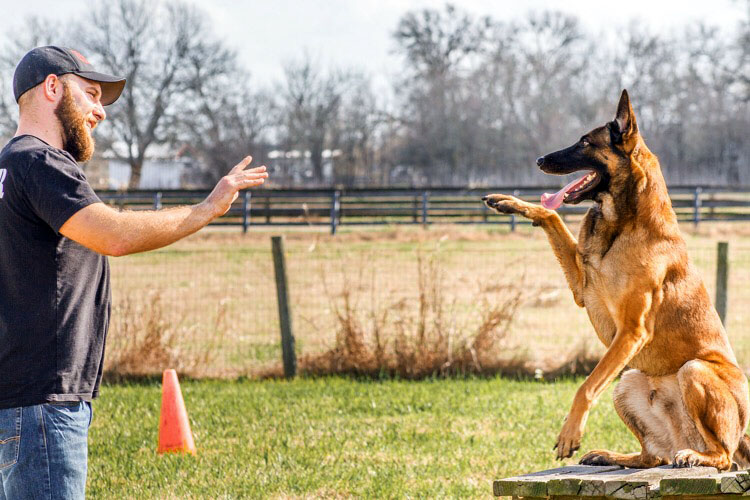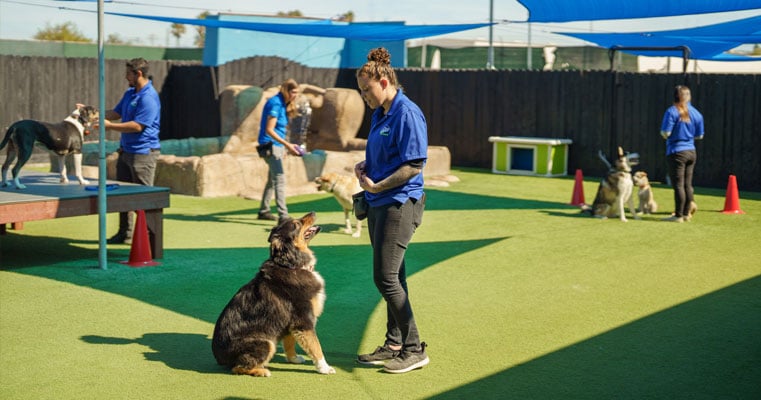The Ultimate Overview to Favorable Reinforcement in Dog Training
The Ultimate Overview to Favorable Reinforcement in Dog Training
Blog Article
Necessary Tips for Successful Dog Training: A Guide for Pet Owners
Reliable dog training is a diverse process that calls for a critical approach tailored to both the family pet's temperament and the owner's goals. Key parts such as establishing consistent commands, utilizing positive support, and helping with early socialization play critical roles in promoting a well-adjusted canine buddy. However, several pet dog proprietors come across obstacles that can prevent development, bring about stress and uncertainty. Understanding how to navigate these obstacles can considerably boost the training experience, eventually transforming the connection between owner and dog. What are the necessary methods that can be utilized to guarantee success in this undertaking?
Recognizing Canine Behavior
Recognizing canine habits is necessary for effective training and cultivating a harmonious connection in between canines and their proprietors. dog training. Pets communicate mainly via body language, articulations, and activities, making it crucial for owners to translate these signals properly.

Socializing plays a considerable role in pet dog habits; exposure to different environments, individuals, and other pets can substantially impact a pet dog's character. Additionally, factors such as breed features and private personality ought to direct training approaches, as some breeds may have details behavioral characteristics that demand tailored methods. By recognizing these aspects, proprietors can produce a supportive environment that encourages favorable habits, leading to effective training results and a deeper bond with their pets.
Developing Regular Commands
Effective communication with your pet dog starts with establishing regular commands. This fundamental aspect of training is essential for cultivating understanding in between you and your pet dog. Consistency in the commands you make use of makes sure that your pet can dependably link details words or expressions with the preferred behaviors.
When choosing commands, select clear, distinctive words that are simple to state and separate from one another. Prevent utilizing similar-sounding commands that may confuse your pet dog. Using "rest" and "stay" is appropriate, however "rest" and "hit" might lead to misunderstandings.
Additionally, keep the very same tone and volume for every command. Dogs are delicate to singing cues, so varying your tone can produce confusion.
It is equally vital to make sure that all household participants get on the exact same page pertaining to the commands made use of. A united front in command usage will certainly protect against blended signals and enhance the knowing procedure.
Favorable Reinforcement Strategies
The power of positive reinforcement in pet dog training depends on its capability to motivate desired actions with rewards and praise. This strategy is grounded in the principle that behaviors adhered to by positive outcomes are most likely to be repeated. By integrating positive reinforcement right into your training program, you can efficiently shape your pet dog's behavior in a constructive way.
To execute positive reinforcement, it's vital to determine what inspires your go to website pet dog, whether it be treats, toys, or spoken praise. When your pet carries out a wanted activity, such as resting on command, quickly reward them with a treat or affection. This organization in between the command and the positive end result strengthens their understanding.
It's critical to timing the benefits correctly; providing the reinforcement within seconds of the desired behavior aids your canine make the link (dog training). Furthermore, uniformity is key-- make sure that all relative use the very same commands and reward systems to avoid confusion

Progressively, you can lower the regularity of deals with as your pet finds out the behavior, transitioning to praise or recurring rewards. This method not only cultivates a solid bond in between you and your canine yet likewise promotes a favorable understanding setting, making training a satisfying experience for both.
Socialization and Interaction
Continually subjecting your canine to a variety of settings, people, and various other animals is critical for their social growth. Socialization needs to begin early, ideally throughout the critical window of 3 to 14 weeks, when young puppies are most receptive to brand-new experiences. Older pet dogs can additionally profit from recurring socialization efforts.
Present your dog to different settings, such as parks, pet-friendly stores, and city locations. This exposure helps them adapt to various stimuli, decreasing anxiety and concern feedbacks. Urge positive communications with various other pet dogs and individuals, guaranteeing that these experiences are risk-free and controlled to foster confidence.
Utilize structured playdates with well-mannered dogs, as this can improve your canine's social abilities and educate them ideal habits. Obedience courses and training sessions also give excellent chances for socialization, permitting your pet to connect with others in a supervised atmosphere.
Screen your pet dog's body language during interactions, as this will certainly aid you assess their comfort degree. Gradually raise direct exposure to even more tough situations while guaranteeing that each experience declares. check my source A well-socialized pet is most likely to display balanced behavior, making them a pleasure to have in any setting.
Addressing Usual Training Obstacles
Every pet owner will run into training obstacles eventually, despite their pet's age or socialization degree. Determining usual problems such as stubbornness, interruptions, and fearfulness can help in developing effective techniques for renovation.

Progressively present distractions as the canine comes to be more efficient in commands. Short, regular training sessions are also efficient in preserving attention.
Terror can prevent a pet dog's knowing process. Gradual desensitization to the source of anxiety, paired with favorable support, can help ease anxiety. Perseverance is critical; never ever require a canine right into a circumstance that triggers distress, as this might worsen the issue.
Ultimately, understanding and attending to these usual challenges with a structured technique will certainly promote a more productive training experience, enhancing the bond between dog and proprietor while advertising effective knowing.
Verdict
In recap, effective canine training counts on a detailed understanding of canine behavior, the establishment of consistent commands, and the application of positive reinforcement methods. Socializing plays an essential function in developing well-adjusted family pets, while attending to typical training difficulties calls for perseverance and adaptability. By carrying out these necessary techniques, pet proprietors can cultivate a solid bond with their pet dogs and promote preferable behaviors, ultimately leading to an unified connection in between human beings and their canine friends.
Understanding pet actions is necessary for effective training and promoting a harmonious connection between canines and their proprietors.Socializing plays a substantial role in canine behavior; exposure to various environments, people, and other pets can dramatically influence a canine's temperament.The power of positive reinforcement in pet training lies in its capacity to urge desired habits with benefits and appreciation. By integrating favorable support into my sources your training regimen, you can efficiently form your canine's behavior in a useful fashion.
In summary, successful pet dog training depends on a detailed understanding of canine habits, the facility of constant commands, and the application of favorable reinforcement methods.
Report this page